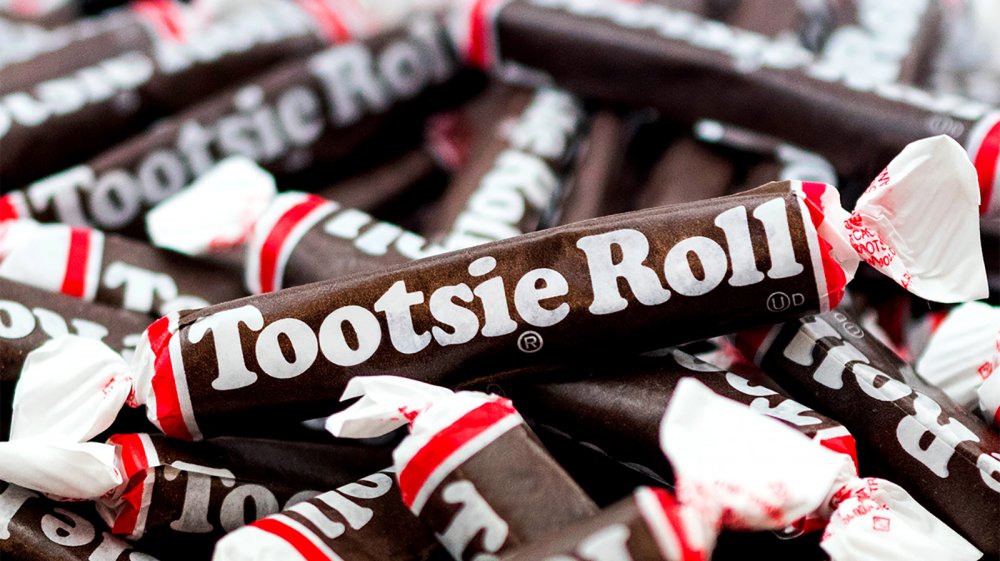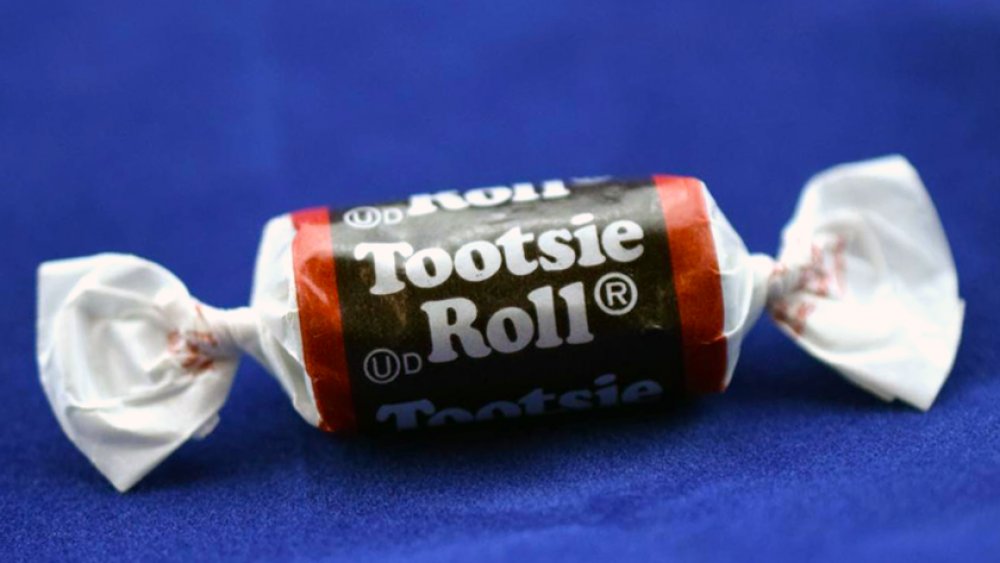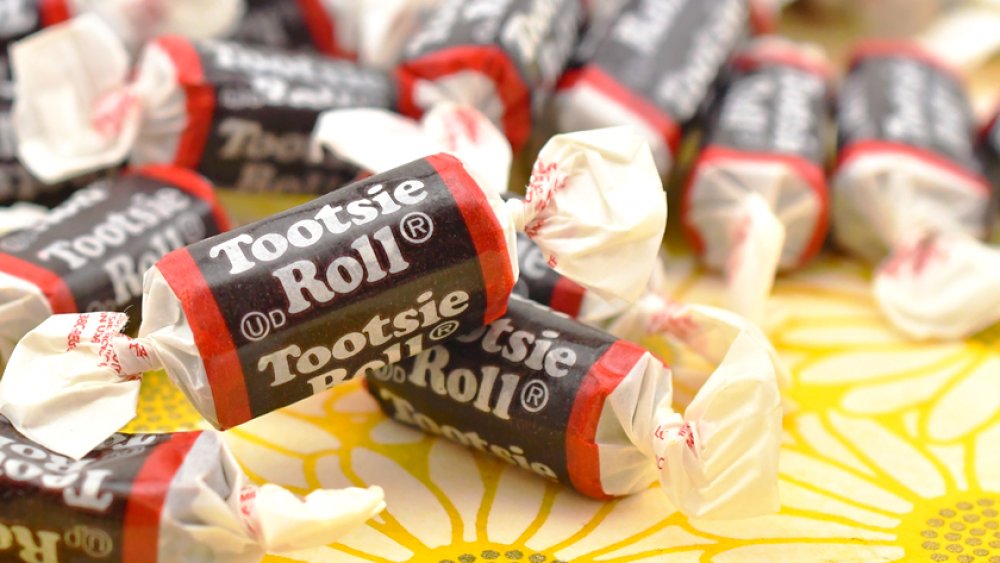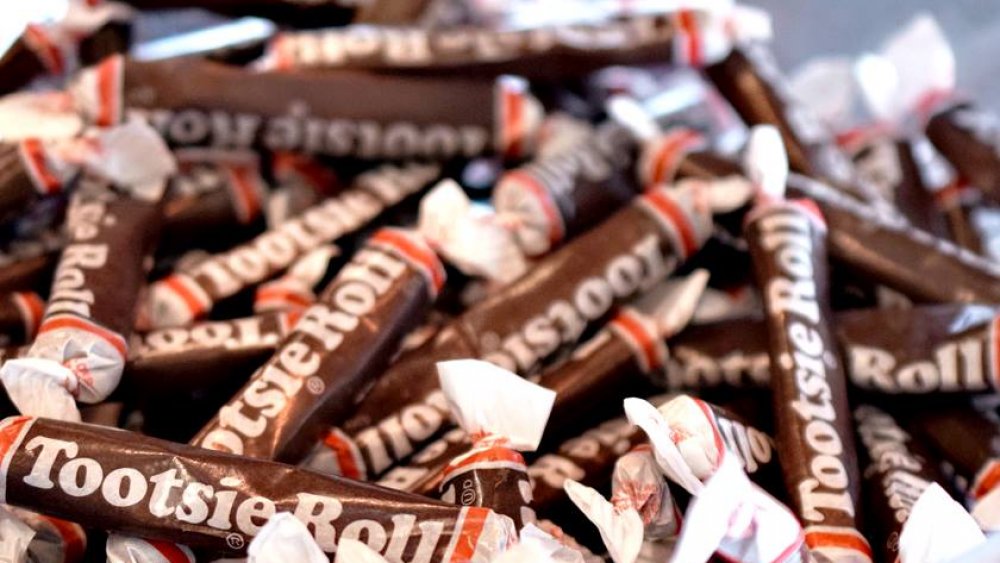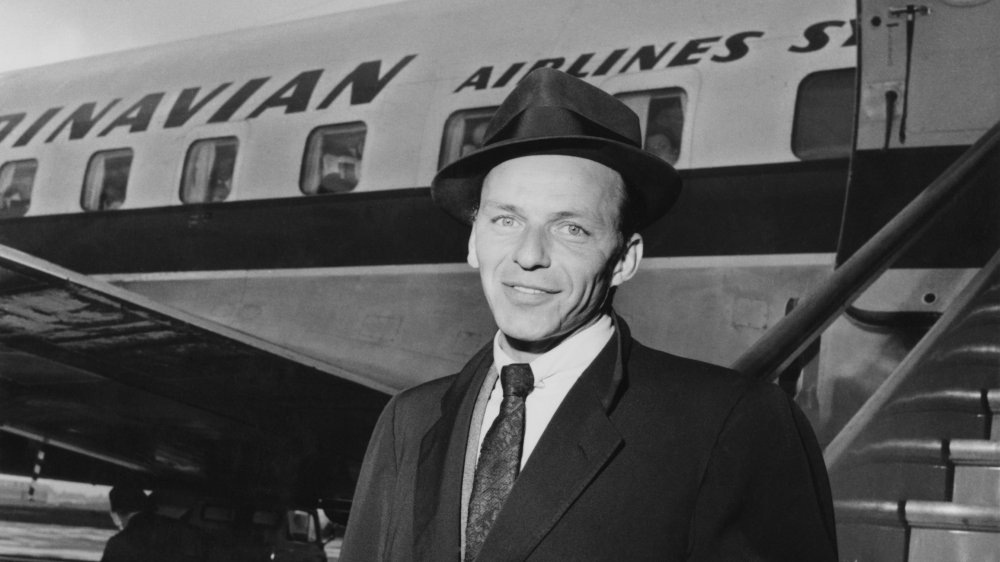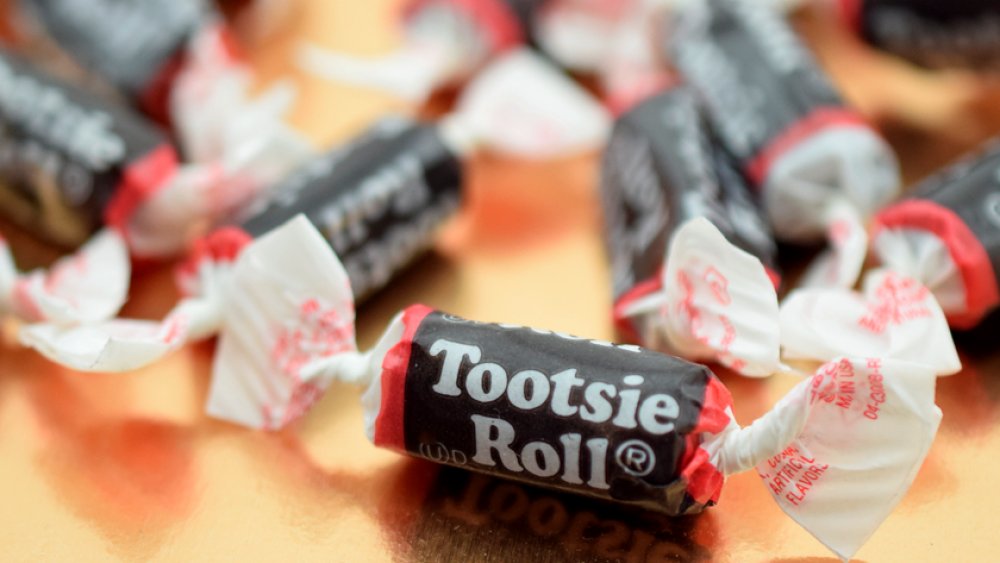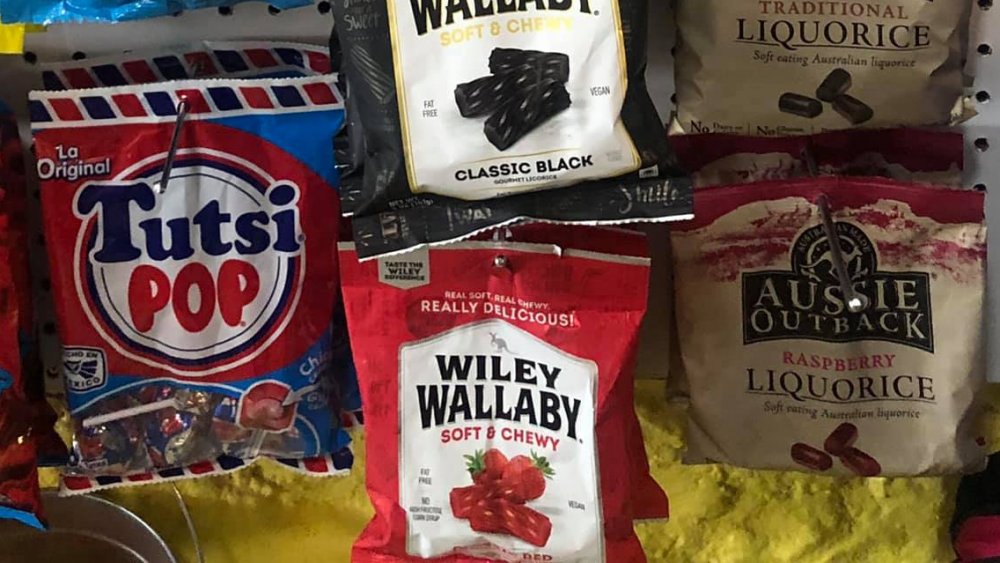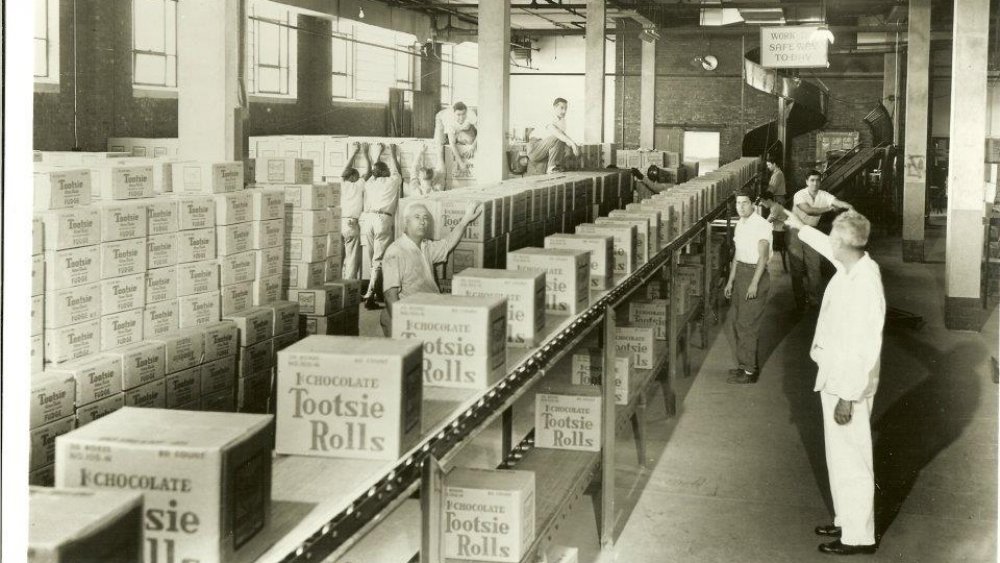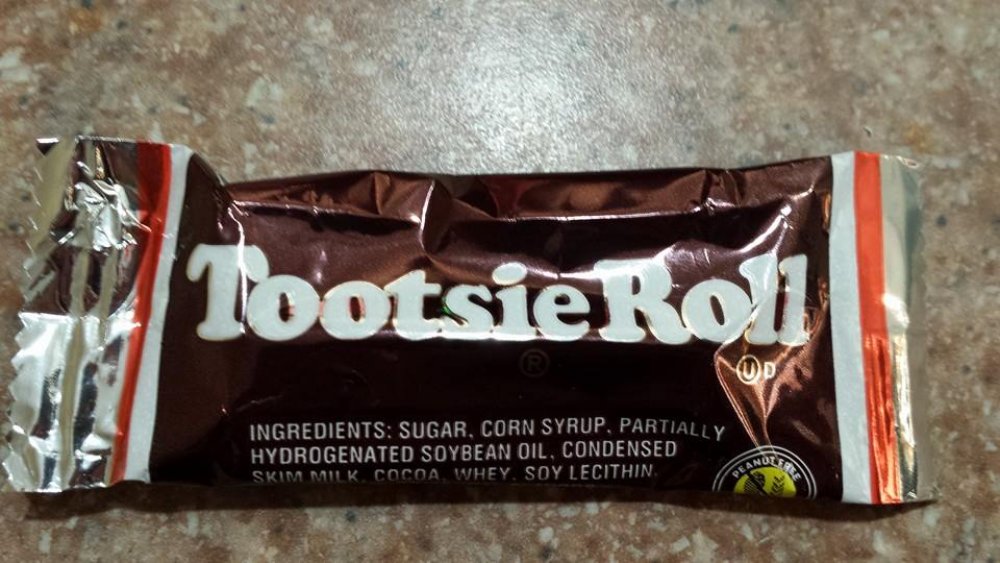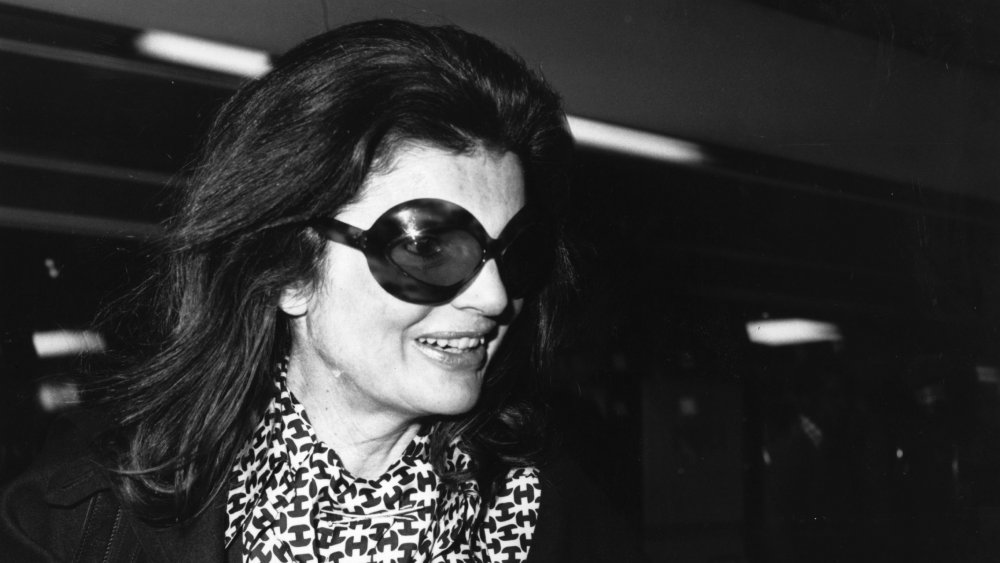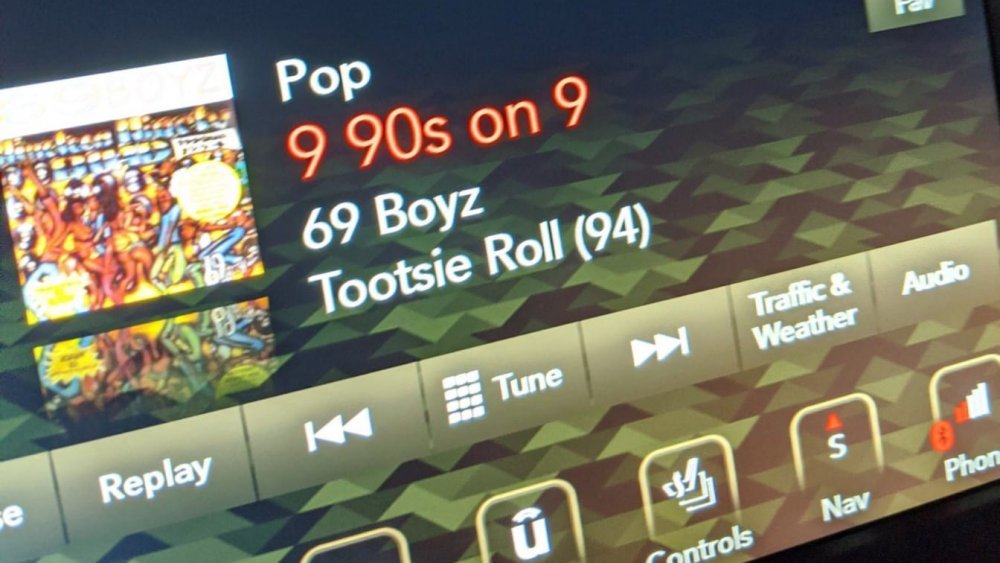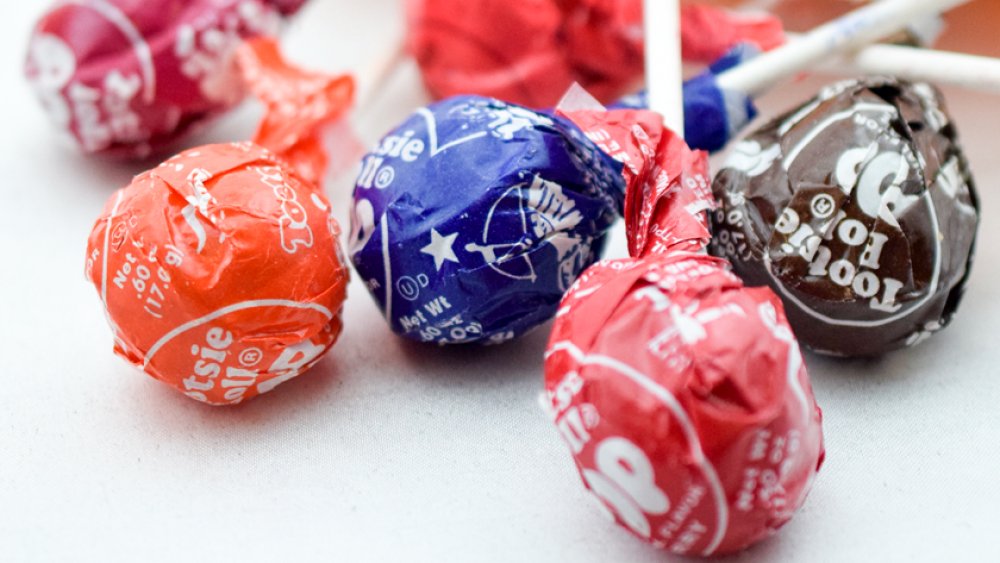The Untold Truth Of Tootsie Rolls
Let's be honest, you probably take Tootsie Rolls for granted because much like a jar of cinnamon in your pantry or loose receipt in your purse, the retro candy has always just been there. A Halloween must-have and one of the most iconic candies, well, ever, Tootsie Rolls are about as American as apple pie and baseball, even though they were technically invented by an Austrian immigrant. That immigrant, Leo Hirschfield, started selling the candy for one cent in Brooklyn in 1896. In 1905, Tootsie Rolls upgraded to an actual factory in New York City, but were still delivered to the consumer via horse and buggy. Fast forward to 1968, and Tootsie Roll moved its headquarters to Chicago, where it is still based today.
Along with some pretty iconic commercials, Tootsie Roll Industries is also responsible for Junior Mints and Blow Pops, along with a host of other candies it's acquired over the years, all while still cranking out 64 million Tootsie Roll candies a day. But there's more to this chocolate, chewy (and sometimes fruity) candy staple than a really famous cartoon owl and a seemingly endless shelf-life, so let's take a behind-the-scenes look at the untold facts of Tootsie Rolls.
At the time of their inception, Tootsie Rolls solved two recurring candy problems
Tootsie Rolls were the first candies sold individually wrapped in 1905. While today that might seem like Basic Hygiene 101 in the candy business, it was a monumental junk food breakthrough at the time.
Another revolutionary aspect of Tootsie Rolls was their ability to deliver a chocolate treat that could really withstand the heat. A major dilemma for candy makers in the early 20th-century was serving up confections that didn't easily melt in the hot summer months (this is obviously before luxuries like air conditioning and refrigeration). And keeping chocolate intact? Forget it. So while they weren't technically chocolate, Tootsie Rolls were a pretty satisfying chocolaty substitute for when a chocolate hankering hit, which essentially gave them god-like status. Hey, if there is a chocolate problem and you solve it, you're bound to make a lot of folks pretty happy.
The origin of the name Tootsie is not entirely clear
While Tootsie Roll Industries' official website claims that founder Leo Hirschfield named the candy Tootsie because it was his daughter Clara's nickname, some scholars disagree. A TIME report about the history of Tootsie Rolls on their 120th anniversary cites Rutgers professor Samira Kawash, who claims that the name Tootsie was actually an homage to an actress who appeared in a commercial for a candy made by Stern & Staalberg, the candy manufacturer that Hirschfield merged with to up Tootsie Rolls' game. Even further, Kawash also claims that her research reveals it's possible Hirschfield was already working for Stern & Staalberg when Tootsie Rolls were invented. The company later became Sweets Company of America, before it was ultimately renamed Tootsie Roll Industries.
So despite some varying information around the exact origins of the name Tootsie, and if the chews began before or after Hirschfield's involvement with Stern & Staalberg, the dedication to the name Tootsie has still remained strong.
Tootsie Rolls nourished soldiers in World War II
When you think about the facets of war and life in the military, you don't usually envision soldiers chomping candy on the front lines. However, confections and the military have often been intertwined throughout the course of American history, and Tootsie Rolls played a part in that story. The tough-yet-still-soft candies were kind of like an early version of an energy bar — the "power bar" before there were actual Powerbars.
In the 1940s, when World War II was underway, both Tootsie Rolls' packaging and consistency were ideal for shipping overseas, and they delivered a quick dose of good-tasting, energy-boosting fuel. The brand was in a sense unofficially contracted with the U.S. government to provide Tootsie Rolls to soldiers as part of their G.I. rations. Tootsie Rolls' contribution to the war effort with their actual product (as opposed to using their factories to produce other necessities) helped the company to continue thriving despite wartimes.
Frank Sinatra required Tootsie Rolls on tour
You've probably heard of the infamous "rider" portion of performer contracts. It's the document that lists all their technical requirements (a certain type of microphone or particular lighting design, for example) and also their, ahem, personal necessities, which can range from Red Bull and cheese trays, or in Van Halen's case, a bowl of M&Ms with all the brown candies removed. The demands of musicians can get downright ridiculous sometimes (we're looking at you, all-white-everything, Jennifer Lopez).
Well, it's been documented that legendary crooner Frank Sinatra AKA Ol' Blue Eyes insisted that Tootsie Rolls — along with a lot of other items including a color TV, various liquors, and an assortment of sandwiches — were part of his backstage dressing room and hotel room demands. In fact, the singer loved the candy so much, he was allegedly buried with a few Tootsie Rolls tossed into his coffin. Enjoying a candy so much that you take it with you to the afterlife? Now that's some serious dessert devotion.
Tootsie Rolls helped American troops win a battle in the Korean War
According to Marine Corps Community Services, the Marine Corps holds Tootsie Rolls in very high regard. This is because the candy essentially saved Marines braving a treacherous battleground in the Korean War.
Soldiers stationed at a mountain reservoir called Chang jin (renamed Chosin Reservoir by the troops) were facing blisteringly cold weather; very low supply and ammunition levels; and an enemy division with a lot more soldiers. Anticipating a drop of "Tootsie Rolls," which was their code name for supplies, the Marines on the ground were surprised when they received actual Tootsie Roll candies. The candies froze in the conditions but were still edible and pliable once they were warmed. So the soldiers used the malleable candy not only as food but also as putty to mend holes. With the ability to fix their equipment, the troops were able to retreat safely past enemy lines and attributed the Tootsie Rolls to helping them survive.
If a food product is capable of getting you out of a war zone and satiating your sweet tooth, we think it's fair to say it's earned a permanent place in American hero-hood.
Tootsie Roll sued a footwear company called Footzyrolls
In 2009, the small footwear company Rollashoe rolled out a new line of rollable (are you seeing a pattern here?) ballet slippers called "Footzyrolls." Seems like a pretty ingenious way to store some ballet flats in your purse if you ask us. A year after their launch, the shoes were being praised in O Magazine and on display at high-end department stores. The brains behind Tootsie Rolls couldn't get excited about these roll-up shoes though, because they were too concerned the name was a little too close to home.
Tootsie Roll Industries sued Rollashoe in 2011, citing trademark infringement, and prior to that, the company had even tried to fight the trademark application from Rollashoe in 2010. The candy makers believed the name "Footzyrolls" was so similar to Tootsie Rolls that customers might assume the two were in cahoots. Moreover, Tootsie Roll lawyers indicated in their filing that the shoe peddlers' decision to use "Footzyrolls" as the name for this line as "willful, malicious and fraudulent." The owners of Rollashoe vehemently opposed any alignment with Tootsie Rolls, maintaining their only intention was creating a comfortable, but very portable, pair of shoes for the heel-weary women of the world.
Tutsi, the Mexian version of Tootsie Roll, might taste a little different
We've got the Aztecs to thank for chocolate — apparently Spanish settlers discovered Montezuma sipping a chocolate concoction made with water, vanilla, and cocoa beans — but the modern-day country of Mexico has the United States to thank for Hershey's and other famous 20th-century chocolate candies.
Chicago-based Tootsie Roll Industries opened its first Mexican plant in Mexico City in 1969. This factory still produces Tootsie Roll products both for Mexican consumption and for exporting to the United States. When sold in Mexico though, the candies are known under the name "Tutsi."
For most of the Tutsi candies made in the Mexican plant for Mexican consumers, the ingredients are sourced from Mexico. In regards to protocols around the Tutsi line, Tootsie Roll Industries head Ellen Gordon told The Orange County Register that, "We do lead testing as a matter of course on incoming raw materials and outgoing finished products ... we are way below the proposed legal guidelines." However, California records indicate that Tutsi candies found in the U.S. tested for relatively high amounts of lead, which could make for a subtle change in taste.
Tootsie Rolls are disturbingly durable
When 95-year-old Tootsie Roll Industries CEO Melvin Gordon died in 2015, he was well revered for his work toward keeping Tootsie Rolls successful for so long, but that's not surprising since he was clearly very passionate about the candy. He insisted that Tootsie Rolls were essentially indestructible, telling the Associated Press in 1996, "Nothing can happen to a Tootsie Roll. We have some that were made in 1938 that we still eat ... if you can't bite it when it's that old, you certainly can lick it." Ellen Gordon, Melvin's wife, former COO, and now CEO of Tootsie Roll Industries, having taken over after his death, also boasted about the candy's resilience, remarking that they were the perfect snack because they could travel so easily and not spoil.
This supposed inability to go bad might or might not be somewhat of a disturbing little tidbit about Tootsie Rolls, but it's impressive regardless of whether you have a preference for how long your candy has lived on the shelf before you put it in your mouth.
Tootsie Rolls were accused of having trans fats in a class action lawsuit
If you want to make a food company sweat, accuse them of using trans fats. The illicit ingredient, also referred to as PHO (partially hydrogenated oils), have been on the no-fly list for quite some time with medical experts and the FDA officially declared the stuff unsafe in 2015. So Tootsie Roll Industries got into some hot water as recently as 2019, for allegedly using trans fats to make their products between 2010 and 2016.
In a class-action lawsuit filing, a woman named Maxine Beasley claimed that Tootsie Roll Industries needed to be held accountable for not acknowledging the presence of trans fats in their candies during that six-year time period. The plaintiff cited that the candy makers continued using PHO, despite being made aware of all the potential health issues. She believed consumers who purchased Tootsie Roll products during that time should be compensated and that Tootsie Roll Industries were breaking the California Unfair Competition Law. The lawsuit is still ongoing but the fat in Tootsie Rolls today is palm oil, which is saturated but not partially hydrogenated.
Jacqueline Kennedy Onassis was a big fan of the office Tootsie Roll bowl
Of the many celebrity fans Tootsie Rolls claim, including Frank Sinatra and Sammy Davis, perhaps one of the most distinguished was former First Lady, Jacqueline Kennedy Onassis. According to Tootsie Roll Industries head honcho Ellen Gordon, Onassis liked to keep a bowl full of the candies around the office at DoubleDay publishing house in New York City because they served as a "good ice-breaker."
Also, a Sun Sentinel piece about Onassis celebrating her 60th birthday in 1989 remarked that Onassis was often seen helping herself to the miniature Tootsie Rolls at her receptionist's desk. There are lots of larger-than-life attributes one regularly associates with Jackie Onassis, like great style and enduring grace in the midst of tragedy. So her weakness for the chocolate chews feels like a trait that makes her seem a little more aligned with the average Joe or Jane.
Tootsie Rolls inspired one of the most popular hip-hop songs of the 90s
In the summer of 1994, the 69 Boyz, a hip-hop group out of Florida, released a hit song named after Tootsie Rolls, affectionately dubbed "Tootsee Roll." Those prone to '90s nostalgia might agree, the "Tootsee Roll" was oh so many things — a dance move, a song, and an homage to its candy namesake and a lady's curves. A staple at college parties and pep rallies, it wasn't just a dance move but also a fully choreographed line dance that had very specific commands. The "Tootsee Roll" was very similar to the "butterfly" dance move but, per the lyrics in the song, not the butterfly in actuality.
"Tootsee Roll" is one of the most memorable hip-hop songs of the last century and while the candy didn't get a cameo in the official music video, there is a deep reverence for the candy's goodness in the song itself.
No one at Tootsie Roll Industries will officially confirm licks it takes to reach the center of a Tootsie Pop
One cannot do an exposé on Tootsie Rolls without mentioning the Tootsie Pop, which was invented in 1931. And you can't mention Tootsie Pops without reminiscing about the iconic commercial and the long-running character born from it, Mr. Owl. In the original 1970 Tootsie Pop commercial, a small cartoon child asks a multitude of frustratingly ill-informed cartoon animals if they can tell him how many licks it takes to reach the center of a Tootsie Pop. You know the rest— he finally gets to Mr. Owl and Mr. Owl devours the sucker in three licks before he can give a truly accurate answer.
To this day, Tootsie Roll Industries fields people trying to answer the question — even groups of students at reputable universities — and still won't really give a definite answer on their end. It's pretty genius marketing, considering that it's hard to not think about wanting a Tootsie Pop to try and determine for yourself. The company even has a comic book strip dedicated to the question. And of course, Mr. Owl now has a Twitter account, that's still teasing us with the question, "How many licks does it REALLY take?"
